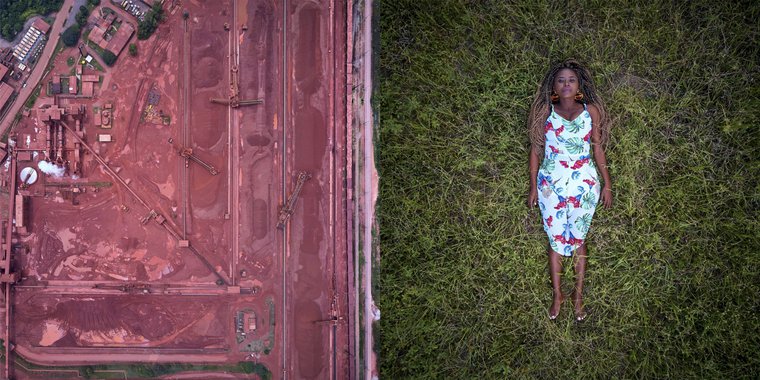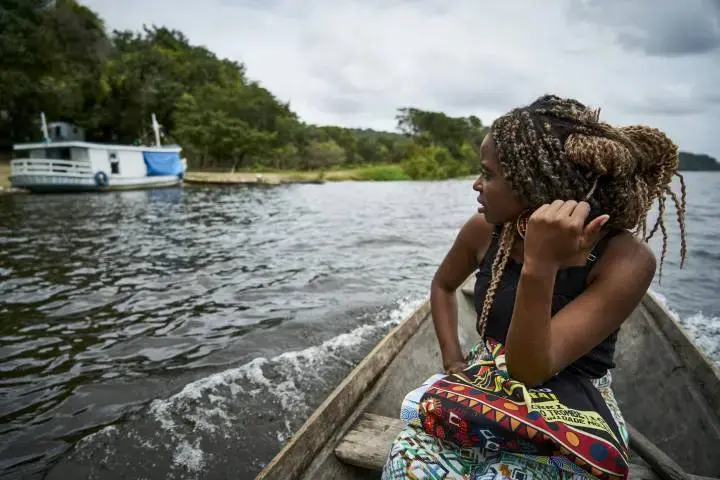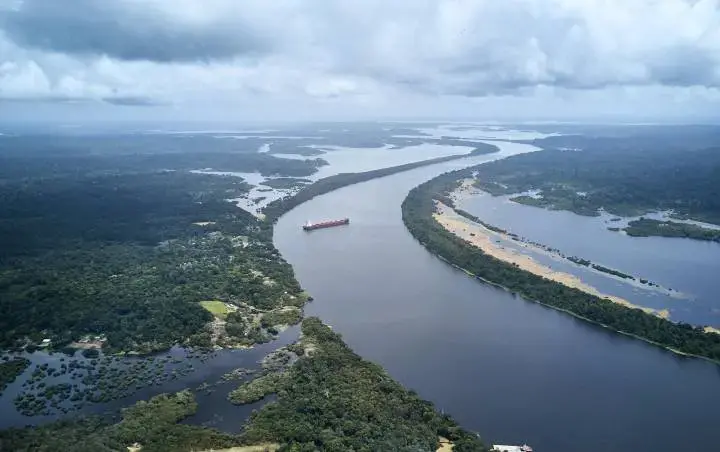
Read the Spanish-language version of this story on OpenDemocracy's website.
The arrival of our motor boat to the Mãe Domingas quilombo, which is located in a biosphere reservation (the Trombetas River Biological Reservation) and can only be accessed with a special permit from the Chico Mendes Institute for the Conservation of Biodiversity (ICMBio), coincides with the end of a community assembly.
The assembly has voted on a proposal that a logging company has made: it will pay what seems like a fantastic yearly rent for the right to exploit the territory. Someone informs us newcomers about the result of the voting: 15 for the loggers’ proposal, 100 against.
Although the quorum is a modest representation of the six communities - Tapagem, Mãe Cué, Abuí, Sacred Heart of Jesus, Santo Antônio and Paraná do Abuí - which make up the quilombola territory coordinated by the Mãe Domingas association, this is a significant result.
It means that the theses defended by 29 year-old Drica, the recently elected leader of the association, have won the day. Mãe Domingas, where Drica lives, is one the most impoverished quilombola territories (eight in all) in the Upper Trombetas River, a tributary on the left bank of the Amazon, in the Brazilian state of Pará.
Life goes on here in humble two or three-house family units. Most houses have wooden walls and palm leaf roofs. They have easy access to the river, which is the fundamental and often the only communication route. There is no energy here, except that coming from a generator which they turn on (when fuel is available) in the late afternoon. They dig wells for drinking water.
The quilombos group several communities. Drica studied in Manaus but returned to Trombetas to be a school teacher at the quilombo. She is now also the leader of the association, which was formed by six communities 18 years ago to defend the interests of the territory.
It is the first time that a woman holds the position. This generates expectations, but some reluctance too in a traditional society such as this. "Machismo has always been present here, from the very beginning. But a barrier has now been broken with my election as coordinator. I hope it helps other women to come up front and do the same", she says proudly.
The origin of these Afro-descendant communities, which exist in different parts of the American continent but are numerically quite significant in Brazil, is important to understand their current condition.
Brazil delayed the abolition of slavery all it possibly could. So much so, that it became the only country where African slaves could be sold freely at the end of the 19th century. The continental dimension of the country and the fertile immensity of its Amazonian basin, occasionally offered slaves the opportunity to flee. But the communities of runaway blacks were strongly repressed.

For slaves, therefore, escaping meant reaching far away, remote places where owners would find it difficult to get to them, although not so far and remote as to prevent them from the necessary contacts to ensure access to essential elements for their survival.
They hid and scattered (avoiding concentration turned out to be an effective defensive strategy) and learned to survive on very little in tiny communities.
Harassed by periodic punitive expeditions which often failed to catch them but devastated their modest settlements, they managed to survive thanks to effective systems of surveillance along the river and their ability to vanish from sight into the tropical forest.
In any case, having to face the extreme conditions of their jungle hideouts compensated for the humiliation, the cruelty and the dehumanization of slavery. Having been torn with inconceivable violence from their homes in Africa, those who managed to survive often lost all reference to their communities of origin. They also lacked the ancestral knowledge of the natives on how to live in the jungle.
Even so, they managed to form communities several thousand strong, some of which survive to this day and have (finally!) seen their property rights recognized over the land they have lived in for generations.
Similarly though to what has happened in native demarcations, the property titles of the quilombos have been beset by speculation and hampered by those seeking to extract bountiful benefits from these resource-rich territories.
Many property title processes are still open, but Jair Bolsonaro’s new government has decided to put a stop to any further granting of land. Thus, for some quilombo communities, such as Drica’s, which have been struggling for decades to have their property rights recognized, this is still an ongoing battle.

The Trombetas quilombos exist since the end of the 18th century at least, when slave labour – acquired in the dealer markets on the Brazilian coast – was required for cocoa growing and cattle raising in the Low Tapajós.
According to the Palmares Cultural Foundation, out of the 3,524 groups left in Brazil, only 154 have had their property titles recognized – that is to say, they have completed the final phase of the process of recognition and protection of the quilombolas. According to data from the National Coordinating Organization of Quilombolas Rural Black Communities (Conaq), another 1,700 groups, including Drica’s, are awaiting the conclusion of anthropological studies or the completion of technical reports to obtain their property titles.
On paper, this grants its inhabitants, the quilombolas, considerable wealth, but it also entails some significant threats - and here is where the struggle led by young people like Drica is essential.
The threats are very serious. Since the 1970s, the Mineração Rio do Norte (MRN), which belongs to a consortium which includes BNP, ALCOA and other corporations - including Vale S.A. (responsible for the Mariana and Brumadinho disasters)-, has been operating a gigantic bauxite mine (bauxite is the main source of aluminum) upstream. According to the company’s own data, the mine extracts 18 million tons of bauxite per year.
Drica maintains that this is an opaque mine, the audits of which have never actually been published. She fears that its tailings ponds could eventually collapse and that the spill would surely mean the end of river life. In fact, she reports, some leaks are already affecting the quality of life of the people living nearby: they cannot use their wells and thus lack drinking water and suffer skin irritation.
But since it started 40 years ago, the mine has been giving people jobs on and off, and has been providing some services to the community so as to win their favor - especially after the quilombolas got their property titles for some of the land, a fact that afforded the mining company the opportunity to negotiate with them an expansion of its extractive activity.
The company does in fact give some cash away, possibly only the mandatory amount under current environmental legislation, but these are merely crumbs compared to the huge benefits that a large mine such as this brings to its shareholders.

The dominant perception, however, is that the mine has always been there: four decades are like immemorial time for this young community which, in addition, is currently experiencing a demographic explosion. In the quilombos, you can see children everywhere – they seem to be there to remind Drica all the time her responsibility to preserve the land.
"Our struggle, like our grandparents’ and great-grandparents’, is to defend this land so that we can hand it over to the new generations just as it was when we received it", says Drica.
Teaching young children to respect the land is what motivates her most. She imagines a future in which these children will grow up to recognize the treasures of this land and know how to preserve them and, at the same time, be aware of the threats that hover over it so that, when the day comes, they will be able to defend it properly.
Even though the quilombo seems to assume the mine as a fatality, this is not the case with the threat that the logging companies pose. Some outline the existance of economic alternative options to the arrival of a foreign logging company with a predatory exploitation model which, in only a few years, would provide the community with an income which now may seem fabulous, but in fact is not.
As this is actually the case, many in the community think that when the company would have finished with the precious local trees, it would simply move on and start to devour the next piece of forest, leaving a trail of overexploitation, social de-structuring and, ultimately, sadness, corruption and death.
Drica, and many more like her, do not even want to address the arguments in favour of logging – be it "sustainable" or otherwise. They made a decision in an assembly, and now they just want to carry this decision through.
The amount of distrust that these Afro-descendants - whose ancestors fled from the most inhuman exploitation of all - have accumulated over the years gives them reason for being suspicious of the white bearded men.
However, the dramatic deprivation and the poverty they are currently facing forces them to start thinking about some sort of income generation model for the time when these hundreds of children will reach adulthood, begin to form families, and try to "progress". Today, life conditions in the quilombo are hard enough, and making the wrong decision could be fatal.
Drica was elected in January and so she is at the start of her two-year term. She will have to learn to deal with the multiple risk factors that threaten the territory.
Being aware that the land in which they live is rich, and that this land now finally belongs to them, is a strong motivation for the quilombo people to keep it intact. "But the biggest threat to our future, beyond the logging companies and the bauxite mine, is the hydroelectric dam", warns Drica. To her, this could be the end of the Trombetas quilombolas.
The project for this huge infrastructure (with a planned capacity of 2,000 MW) to be located upstream, in Cachoeira Porteira, has been under study for some time now, but has recently regained momentum as part of the Barão do Rio Branco Plan, the “development” project for the Amazon which is being promoted by the Bolsonaro government. This has been confirmed by General Maynard Santa Rosa, one of his seven military ministers.
Drica foresees the river running dry and her people being reallocated in small, cloned, state-owned houses in the outskirts of Oriximiná or Santarém. It would not be the first community in the region to end up like this.
Drica foresees also an increase in violence, in drug and alcohol consumption, in uprootedness, sadness and ruin for her people. Above all, she foresees the violation of the school children’s happiness, their morning swim in the river, the sounds of the jungle that make up the soundtrack of their lives.
Drica foresees the end of the botos’s magic, the freshwater dolphins showing their silvery backs at sunset, and the end of the delight of watching a mango falling from the enormous tree that presides over the children’s joyful play.
Drica is a courageous, empowered woman, but she has a very difficult task ahead of her. The risks that hover over her people, in addition to the bauxite mine, the logging companies and the hydroelectric project, are unfathomable. She perceives, above all, the defenselessness that Bolsonaro's policies can mean in practice for her people.
The catastrophic dimension that these threats could pose at some point in time overwhelms her. But there is resolve in her eyes, an old pride and rebelliousness inherited from her grandparents and great grandparents who fled brutality and slavery to become free.
Drica’s and her people’s life conditions are very harsh, but theirs is an almost defiant pride. Despite their vulnerability, they are determined not to let anything or anybody take away their land and their conquered freedom. They are free since the time of the mythical Mocambo, a large 18th century quilombo established upstream which historians have determined was called Cidade Maravilla (Wonder City), from which they claim to descend.
Today, the registered quilombolas in the Upper Trombetas are nearly 10,000, and Drica and her people are determined to resist. After all, their history is a history of rebellion and resistance.
Today, however, resisting racism, contempt and hate, and the carte blanche which builders, landowners, loggers, miners and other extractivists who feel protected by the Bolsonaro government enjoy, is a major challenge – a colossal one.
Drica will need the backing of the whole community. She will need all of her strength, and all her heart, in order to win.





